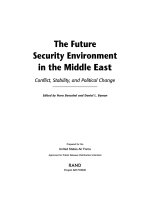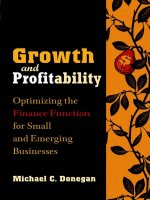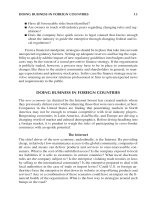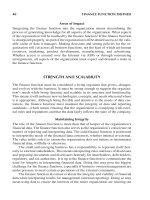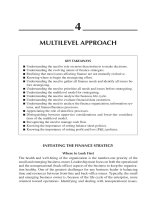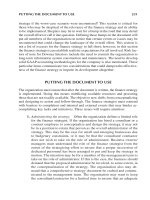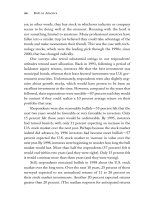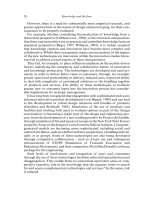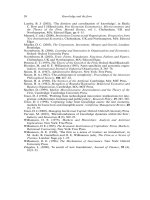The Future Security Environment in the Middle East Conflict, Stability, and Political Change phần 3 pot
Bạn đang xem bản rút gọn của tài liệu. Xem và tải ngay bản đầy đủ của tài liệu tại đây (104.95 KB, 37 trang )
Political Reform in the Middle East 55
Sensitivity to U.S. Ties
Many states in the Middle East maintain good relations with the
United States, ranging from diplomatic support for U.S. policies to
allowing U.S. military forces to be stationed on their territory. Yet
many of these states prefer to keep those policies as far out of the
public view as possible, since anti-American sentiment runs strong
throughout the region. We do not know how deep or widespread this
sentiment is, because reliable public opinion data on this subject
remain very limited. In Saudi Arabia, where such data are virtually
nonexistent, anti-American sentiment could be much deeper and
more widespread than we currently think. We do know, however,
that regimes remain extremely concerned about appearing too close
to the United States and often go to great lengths to keep coopera-
tion as invisible as possible.
If anti-American sentiment is as widespread as regimes currently
fear, or if it increases in the wake of the U.S. campaign against
terrorism in Afghanistan and beyond, political reform could have a
very adverse effect on regional cooperation with the United States.
Both democratization and liberalization enable people to express
their preferences more easily, and if those preferences really are for
reduced cooperation with the United States, regimes will have an in-
creasingly difficult time justifying their current policies. This could
lead to pressure for less open cooperation, especially regarding U.S.
military forces stationed in the region. Regimes may become even
more reluctant to reach formal security agreements with the United
States, because domestic audiences see such agreements as proof
that the regimes are incapable of providing security without external
assistance. Increased sensitivity to ties with the United States could
also spill over into decreased support for other U.S. regional initia-
tives, such as the peace process, anti-proliferation measures, and
counterterrorism.
CONCLUSION
The United States has contradictory interests in Middle Eastern
political reform. It has a normative interest in seeing democracy and
civic freedoms spread around the world, since these are fundamental
American values. In the Middle East, however, such developments
56 The Future Security Environment in the Middle East
could potentially undermine the U.S. interest in regional stability
and continued security cooperation. Whether this potential comes
to pass depends largely on the ways in which regional regimes
choose to pursue political reform. Slow political reform is more
likely to serve U.S. short-term interests than rapid reform, because
the forces that oppose security cooperation with the United States
are more likely to be contained. As time horizons shift to the longer
term, the United States has an interest in ensuring that the reform
process continue steadily on, so that citizens enjoy greater political
participation and can hold their regimes accountable for their behav-
ior. If such reform does not progress, increased popular frustrations
could increase instability by spilling over into conflict or even over-
throwing their current regimes. Such outcomes, while not extremely
likely, would seriously damage the U.S. interest in regional stability.
57
Chapter Three
ECONOMIC REFORM IN THE MIDDLE EAST: THE
CHALLENGE TO GOVERNANCE
Alan Richards
Many students of the world economy portray Middle Eastern
1
coun-
tries as “global losers,” lagging seriously behind other major world
regions.
2
Looking ahead, the economic challenges facing the region
are certainly severe, while the policy response appears limited. A
comparison of the region’s performance either with that elsewhere in
the world or with the severity of the challenges facing the region
leaves little room for optimism. Economic stagnation undermines
regime legitimacy and even, in some cases, the capacity to govern.
The problem is particularly serious because stagnant economies
cannot provide adequate jobs for the rising tide of young job seekers.
The mixture of regime incapacity, rising unemployment and poverty,
and very young populations is politically highly volatile.
At the same time, important changes in economic and social policy
have been made in the last five to ten years. Such changes, particu-
larly when combined with a possible “silver lining” in demographic
developments, offer a more hopeful perspective. Further, from the
perspective of local ruling elites, these problems may be “disastrous,
______________
1
“Middle Eastern” here means Iran and the Arab countries; the focus among Arab
countries will be on Egypt and the Asian Arab countries, although some reference will
also be made to North African countries.
2
See Thomas Friedman, The Lexus and the Olive Tree, New York: Farrar, Straus,
Giroux; 1999; Gary Hufbauer, China, the United States and the Global Economy:
Trends and Prospects in the Global Economy, Washington, D.C.: Institute for
International Economics, November 1999.
58 The Future Security Environment in the Middle East
but not serious.” Many of the economic problems facing Middle
Eastern countries have been serious for at least a decade. In no case
has the problem, however severe, posed a fundamental threat to the
stability of the regime (with the arguable exception of Algeria). Al-
though the lives of many young people in the region are significantly
impoverished by their inability to obtain a job that meets their
expectations, the political consequences have so far been contained
by the “muddling through” approach of most governments to
economic policy change.
The durability of this seeming stability is doubtful. In particular, the
mounting pressures outlined below may well have a cumulative ef-
fect. Economic policies have changed—but the changes have not
raised living standards much. One may be also highly skeptical con-
cerning the sustainability of such limited growth as it has occurred.
Evidence from such sources as the World Bank strongly suggests that
problems of environmental degradation in the region are sufficiently
severe that recent increases in per capita income—desultory as they
are—may be entirely illusory. When ecological constraints
(especially those of water supplies) are included, the challenges fac-
ing the region during the medium term appear more daunting still.
Just because regional elites have maintained their power so far does
not mean that they will be able to continue to do so in the medium
run. The easy (typically, budgetary and macroeconomic) changes
have typically already been implemented, yet unemployment and
stagnant living standards persist. Many (e.g., the World Bank) advo-
cate deeper changes in response. These may or may not produce the
desired results; however, such changes do pose a greater challenge to
existing habits of governance: Greater reliance on the rule of law
typically threatens the levers of state power; reduced reliance on
public-sector employment usually implies greater negotiation with
significant private agents, etc. It is unsurprising that such changes
are more strongly resisted, and it is far from clear that they can be
implemented without profound political change.
During the past 20 years, there has been some consensus on what
economic policies ought to be adopted to improve economic man-
agement and thereby to restore growth of incomes and job creation.
This view holds that only a private-sector led, export-oriented
Economic Reform in the Middle East: The Challenge to Governance 59
economic development strategy has a chance of coping with the de-
velopment challenges facing the region. This consensus is best ar-
ticulated by the World Bank and IMF,
3
but it has many other adher-
ents, particularly in the U.S. government and in American academia
and think tanks. Key elements of this “Washington Consensus” in-
clude government budgetary balance, low inflation, market deter-
mined prices, and reduced reliance on direct, quantitative govern-
ment regulation.
No one has formulated a more persuasive policy mix than the Wash-
ington Consensus for the Middle Eastern context. However, two im-
portant caveats deserve emphasis. First, there are reasons to fear
that, although the Washington Consensus may be the best available
strategy, it too may fail, especially for the very poor nations and the
relatively rich states of the Gulf Cooperation Council (GCC.) The best
strategy may just not be good enough, given the magnitude of the
challenges and some specific features of regional political
economies. Second, the strategy also faces formidable obstacles in
other countries of the region where the strategy might more plausi-
bly work.
It may be argued, of course, that economic failure will not automati-
cally translate into political disaster. There is no consensus on how
deeply these economic challenges threaten existing regimes. Al-
though mounting economic difficulties pose grave challenges to gov-
ernance for all regimes, as discussed in Chapter Two, there is much
uncertainty about how well various regional governments can man-
age these challenges. At one extreme, these challenges may under-
mine not only governance, but also governability. In some countries,
particularly the poorest ones, the challenges may overwhelm any
governmental structure, leading to the collapse of order, as in
Afghanistan or Somalia. However, even very deep economic prob-
lems may not bring down regimes that can continue to funnel
enough patronage to key supporters and to repress dissidents. There
is no simple correlation between economic stagnation and govern-
ability.
______________
3
See World Bank, Claiming the Future: Choosing Prosperity in the Middle East and
North Africa, Washington, D.C.: The World Bank, 1995; International Monetary Fund,
Building on Progress: Reform and Growth in the Middle East and North Africa, Wash-
ington, D.C.: International Monetary Fund, 1996.
60 The Future Security Environment in the Middle East
Regional governments and elites have so far shown a marked prefer-
ence for a gradual, even dilatory pace of reform. The reasons for this
vary from case to case, but are typically a combination of two factors.
First, regimes fear—with some reason—that the social dislocations
that full-scale economic reform would entail run a high risk of being
politically destabilizing. Second, powerful vested interests either
block reforms or ensure that the specific kind of reform yields dis-
proportionate benefits to them, at the expense of other social groups.
The result has been a very mixed picture, in which regimes have em-
braced some, and often many, economic reforms (especially in
macroeconomic policy), yet they have postponed or evaded more
complex reforms, such as privatization, reform of regulatory rules,
and development of the rule of law. Whether because of the inherent
difficulties facing any economic policy, or thanks to the unevenness
of reform, the results have been disappointing. Although in some
countries economic performance in the mid- to late-1990s was con-
siderably better than that of the previous ten years, in no country has
growth as yet been fast enough to lower unemployment and to raise
real wages and living standards.
From a U.S. political perspective, the performance of the past decade
may offer the worst of both worlds. Regimes are widely perceived as
kowtowing to Washington and “embracing Western dictates.” This
makes them vulnerable to Islamist criticism, which, of course, tran-
scends economic policy matters. However, failure of the reforms to
deliver reduced unemployment and rising living standards makes
World Bank appeals to “press on” with reform increasingly less per-
suasive to many people in the region.
The rest of this chapter has three parts. The first reviews the basic
economic challenges facing the region. These challenges threaten
governance and political stability in two ways: directly, since some
challenges lead citizens to challenge governments (e.g., the youth
unemployment problem) and indirectly through states’ responses to
the economic challenges (e.g., budgetary austerity). Second, the
chapter briefly reviews the reform performance of selected key
countries: Egypt, Jordan, Iran, Saudi Arabia, and Syria. Third, the
chapter summarizes the implications of the interaction of economic
challenges and policy responses for governability and political sta-
bility.
Economic Reform in the Middle East: The Challenge to Governance 61
THE KEY ECONOMIC CHALLENGES FACING THE REGION
The key challenges facing Middle Eastern economies in the medium
term include: restoring economic growth, restraining population ex-
pansion, providing jobs, alleviating poverty, coping with urbaniza-
tion, saving water and halting environmental destruction, obtaining
food, and attracting money for investment. Each is discussed in turn.
Restoring Economic Growth
The recent experience with economic growth has been dismal.
During the past 20 years, Organization for Economic Cooperation
and Development (OECD) countries have seen their per capita in-
comes rise by some 1.4 percent per year. East Asia (excluding Japan)
has, of course, grown much faster, at 5.8 percent per year, a rate that
doubled per capita incomes in 12-1/2 years. Even Latin America,
with its notorious “lost decade” of the debt-ridden 1980s, saw per
capita incomes rise at just under 1 percent per year during the past
two decades. By contrast, per capita incomes in the Arab states to-
day are little different from what they were in 1980; some analysts
would argue that per capita growth has actually been negative, which
is clearly the case for some countries, notably the Kingdom of Saudi
Arabia.
4
Real wages and labor productivity today are about the same
as in 1970. This performance is the worst of any other major region
of the world except for the countries of the former Soviet Union.
Even sub-Saharan Africa has done better.
Both geography and history have conspired to undermine growth.
The region has been cursed by a geographical inheritance of little
water, much oil, and a highly strategic location. Despite the
enormous sums of foreign exchange that oil revenues have supplied,
oil has been a very mixed blessing. Most analysts concur that oil
revenues weakened the competitiveness of non-oil traded goods and
reduced pressures toward more accountable governance. Oil rents
encouraged governments to deepen and extend already existing
______________
4
Hufbauer, 1999; World Bank, World Development Report 2000, New York and Oxford:
Oxford University Press, 2000.
62 The Future Security Environment in the Middle East
state-centered, inward-looking, import-substituting policies.
5
Oil
also contributed to a continuation of baleful 19th century legacies of
strategic location, which, arguably, distracted elites from the task of
economic development by forcing them to concentrate on national
defense questions, and to continue traditions of dictatorial, arbitrary
governance.
Oil price booms laid a weak foundation, and oil price collapse
wreaked further damage. The decline of real international oil prices
in the early to mid-1980s sharply shifted the terms of trade against
the region. As World Bank analysts put it, “Oil prices and output go
together.” Oil prices were as important for such non-oil countries as
Yemen and Sudan as for oil exporters—through the mechanism of
labor remittances, the entire region shared in the massive
transference of oil rents that characterized the period of 1973 to 1982.
(The elasticity of remittances with respect to oil prices is about 0.6.)
From a political perspective, poor growth performance matters only
if measured growth (say, GDP or GNP) is a reasonably accurate mea-
sure of families’ incomes and welfare. Although the overall impres-
sion of both “oil boom” and “oil bust” is valid, there are reasons for
skepticism about both the speed of the boom and the depth of the
bust. There was less growth, and certainly less sustainable develop-
ment, during the boom than the national accounting data suggest.
This is simply because of the key role of oil, a depletable natural re-
source, whose rents accrue directly to the government. From a long-
term, development perspective, much of the measured “growth” of
the oil boom years was not a sustainable income flow, but included
receipts from the drawing down of an exhaustible resource. As El
Sarafy demonstrates, correcting for this feature can have a substan-
tial impact on adjusted GDP—by 5 percent for Egypt and Tunisia, for
example, and over 13 percent for Oman.
6
The boom years also over-
______________
5
Rent is used throughout this chapter in the orthodox economic sense: the difference
between market price and the opportunity cost of production. For a further discussion
in the Middle Eastern context, see Alan Richards and John Waterbury, A Political
Economy of the Middle East, Boulder, Colo., and London: Westview Press, 2nd ed.,
1996, p. 17.
6
Salah El Sarafy, “The Proper Calculation of Income from Depletable Natural Re-
sources,” in Y. J. Ahmad (ed.), Environmental Accounting for Sustainable Development,
Washington, D.C.: World Bank, 1993.
Economic Reform in the Middle East: The Challenge to Governance 63
state the development of these economies since the boom was, of
course, based not on changes in quantities but on shifts in prices:
Unlike the East Asian case, incomes in the Middle East grew for the
reasons that were fundamentally exogenous to the difficult process
of structural transformation. This matters, because the entrenched
habits of rent collection provide poor preparation for today’s hyper-
competitive international economy.
It is instructive to compare the stars of economic development, the
East Asians, with Middle Eastern and North African (MENA) coun-
tries. The World Bank undertook the methodologically standard
comparison of growth of the two regions from 1960 to 1985.
7
They
did this through a residual calculation, in which incomes per capita
are a function of investment and education. Since these variables
explain only 45 percent of the difference in East Asian and MENA
growth, the authors asserted that “55% of the differences in growth
are due to productivity differences.” Such a conclusion is far too san-
guine. For the Middle East, much of the change in the value of out-
put was simply the result of price changes and not the fruit of any
(efficient or inefficient) process of investment. Such considerations
suggest that the gap between East Asian and MENA countries was
even larger than the 55 percent calculated by the World Bank.
Although one might logically argue that, if national income data
overstate the growth of regional economies during the oil boom,
then these same data should understate the extent of the decline of
the economies during the past 15 years. However, particularly from
a political perspective, there is an asymmetry here. First, oil export
quantities have fallen little, if at all—there has been little change in
the depletion of the depletable resource. Second, the informal econ-
omy, which by definition is not measured, is surely not only large to-
day, but larger than it was in the past. As the measured economy
shrinks or stagnates, many have shifted their activities to unmea-
sured activities.
From a political perspective, what matters is the consumption level
of households, whether relative to others or to the recent past. Con-
sumption levels have fallen in many cases, and are under consider-
______________
7
World Bank, Claiming the Future, 1995.
64 The Future Security Environment in the Middle East
able strain everywhere, but the informal economy and household
networks have probably protected household incomes more than
national accounting data would suggest. The “windshield survey”
technique suggests that incomes have fallen less than national data
suggest.
What really counts politically are perceptions,
8
and here there is little
doubt that regional perceptions are of stagnation and declining in-
come standards. Certainly most indigenous observers of the region,
local residents, economists, pundits, and the like concur that times
are hard. There is a widespread perception that the oil boom years
presented opportunities, and that these opportunities are now gone.
Often, such observers are not slow to blame national governments
for these perceived failures.
In summary, regional (and national) growth performances have
been, at a minimum, unimpressive during the past 15 years. The
dominant impact of oil rents has confused the situation to some ex-
tent, but there is little doubt that the region has performed poorly,
and that many people are no better off, and many people are worse
off, than they were 15 years ago. Governments helped to create this
situation: Understanding the current crisis in the region requires
recognizing that the oil boom, coming historically on the heels of
post-independence import substituting industrialization strategies,
spawned the same vested interests, fostered the same mind-sets, and
underwrote the very social contracts that today block policy
adaptation. Oil price declines created pressure to reform, but so far,
governments have been unable to overcome the baleful legacies of
recent history.
Restraining Population Expansion
The two key demographic facts of the region are that the rate of
population growth remains high, and that fertility rates have been
falling rapidly during the past decade. The population of the Middle
East and North Africa is now growing at about 2.7 percent per year.
______________
8
“Men in general are as much affected by what a thing appears to be as by what it is,
indeed they are frequently influenced more by appearances than by reality.” Niccolo
Machiavelli, Discourses on Livy, I.25.
Economic Reform in the Middle East: The Challenge to Governance 65
At this rate, the population will double in about 26 years. This is
the fastest rate of growth in the world, exceeding even that of sub-
Saharan Africa. However, population growth rates have fallen quite
sharply in the past ten years, from 3.2 percent in the mid-1980s to
2.7 percent in the mid-1990s. Sharp fertility declines caused this
change; there are reasons to expect further falls.
This generalization hides substantial variation across countries and
regions. Although population growth rates and total fertility rates
have fallen markedly in Egypt, Iran, and Tunisia, they have remained
stubbornly high in Gaza and Yemen. Indeed the total fertility rates in
Gaza (7.5) and Yemen (7.4) are among the highest in the world. The
Gazan rate is also very high in relation to per capita income.
Even countries whose fertility rates are falling rapidly will continue to
experience population growth, both because fertility remains well
above replacement levels and because past population growth en-
sures that there are many women who will soon enter their child-
bearing years (so-called “demographic momentum”). The popula-
tion of the region may reach roughly 600 million by 2025, some six
times more people than in the 1950s. Such growth poses numerous
economic challenges, ranging from food and water to jobs and
housing.
Rapid past population growth combined with sharp falls in fertility
have two major implications. First, most Middle Easterners are
young. In Iran, for example, half of the population is less than 15
years old. By 2025, the number of people aged 0–14 years will
roughly double. Second, as Williamson and Yousef have argued, the
rapid fall in fertility may lead to a rapid decrease in the “dependency
ratio” (the number of people under 15 and over 65 to the working-
age population).
9
When this has happened elsewhere, as in East Asia
in the 1970s and 1980s, dramatic increases in national savings rates
ensued. For Williamson and Yousef, the demographic change
caused the savings change (this is the natural result of their life-cycle
savings model). They are quick to note, however, that whether such
savings find their way into productive and job-creating investment
depends on many other factors.
______________
9
Jeffrey G. Williamson and Tareq Yousef, “Demographic Transitions and Economic
Performance in MENA,” unpublished paper, Harvard University, 1999.
66 The Future Security Environment in the Middle East
Providing Jobs
These savings will need to be channeled into job-creating invest-
ment, if unemployment and/or falling wages and rising poverty are
to be averted. For at least the past decade, the supply of labor has
outrun the demand for workers every year. Past high fertility levels,
combined with rising female participation rates (from very low lev-
els) have created the most rapidly growing labor forces in the entire
world (3.4 percent per year, 1990–1998).
10
In some countries, the
situation is even more serious, including Algeria (4.9 percent), Syria
(4.8 percent), and Yemen (5.6 percent).
11
Although the rate of
growth attributable to past population growth will decelerate in
some countries (e.g., Tunisia) during the next ten to 15 years, the
decline in fertility is, as always, accompanied (largely caused by)
rising female education—which also simultaneously leads women to
seek to enter the labor market. It is highly unlikely that the growth of
the supply of labor will decelerate within the medium term.
At the same time, the demand for labor has grown sluggishly. Simple
economics tells us that, given such a mismatch between the growth
of demand and supply, either the wage will fall, unemployment will
rise, or (most likely) some combination of both will occur, with the
precise mix varying with specific labor market structures. Govern-
ment policies have not only reduced the rate of growth of the de-
mand for labor, but have also fostered inflexible labor markets.
Decades of government job guarantees for graduates have induced
students to seek any degree, regardless of its utility in the production,
since a degree, by itself, has long been a guarantee of a government
job. Governments cannot now provide the necessary jobs, but statist
policies impede private-sector job creation. Meanwhile, the educa-
tional system has produced large numbers of young people with
enough education to be unwilling to work at manual labor jobs, but
insufficient skills to be productive in today’s world economy.
Despite data difficulties, several generalizations may be made. Cur-
rent levels of unemployment are high, as Table 3.1 demonstrates,
______________
10
World Bank, World Development Report 2000.
11
By way of comparison, the labor supply has grown at 0.8 percent in the United
States and 0.4 percent in the European Union.
Economic Reform in the Middle East: The Challenge to Governance 67
Table 3.1
Unemployment in the Middle East: A Compendium of Estimates
Country
Unemployment
Rate Remarks
Algeria 30 percent Data from 1999.
Egypt 12 percent Data from 2000. Some estimates
are as high as 20 percent.
Iran 20 to 25 percent Data from 2001.
Jordan 15 percent Official rate. 1999 CIA estimated
25 to 30 percent.
Lebanon 18 percent Data from 1998.
Libya 29 percent Data from 2000.
Morocco 15 to 22 percent Data from 2000.
Saudi Arabia 14 to 18 percent Rates are higher among
graduates.
Syria 12 to 15 percent Data from 1999.
Tunisia 16 percent Data from 1999.
Yemen 35 percent Data from 1999.
SOURCES: Saudi Arabia, U.S. Embassy, Riyadh, and New York Times,
8/26/01; Iran, Eric Rouleau, Le Monde Diplomatique, www.en.monde-
diplomatique.fr/2001/06/05iran; all others: MEDEA Institute (European
Institute for Research on Mediterranean and Euro-Arab Co-operation),
and CIA World Fact Book, 2001.
and the problem will probably get worse in the near to medium run.
Unemployment primarily affects young, semi-educated, urban peo-
ple, whose anger fuels political unrest. Unemployed youth provide
fertile fishing ground for Islamist radicals throughout the region. The
problem posed to governance is severe.
The remedy to the long-term problem has worsened and in many
cases will continue to worsen the problem in the short term. De-
mand for labor has grown sluggishly both because output growth has
lagged, and also because of specific policy biases against labor-
intensive, job-creating growth. Not only do the statist, inward-
looking policies sketched above retard growth, but they also raise the
capital-intensity—and reduce the job-creating effect—of whatever
growth does occur. But changing these policies requires laying off
workers in state-owned enterprises and the bureaucracy, a move that
frightens many leaders.
The employment problem is the most politically volatile economic
issue facing the region during the medium term. Unemployment
68 The Future Security Environment in the Middle East
encourages relatively educated, young, urban residents to support
radical Islamist political movements. There are, of course, many
complex cultural forces behind these movements; no “economic
determinism” is implied here. The Ayatollah Khomeini is reported to
have said that “the revolution is about Islam, not the price of mel-
ons.” Much deeper issues of identity and legitimacy are at stake. For
example, we should remember that although unemployed, frustrated
young men throughout the region can turn to Islamism, they can
also turn to drugs and crime, to apathy, indifference, muddling
through, dogged hard work, or any number of other, personal
“coping” strategies. The decision to join a revolutionary movement
is a deeply personal, idiosyncratic one. Socioeconomic contexts are
important for understanding these movements, but they hardly pro-
vide a full explanation for them. Nevertheless, huge numbers of dis-
contented young men (and women) are a major threat to internal
stability throughout the region.
Alleviating Poverty
There is a large and growing debate about the extent and severity of
poverty in the region. Since the definition of both is inherently sub-
jective, such debate is hardly surprising. With the exception of a few
countries, the debate rages in the absence of good data. This analysis
offers the following generalizations on the state of poverty in the re-
gion.
12
• Only Jordan, Morocco, and Tunisia have estimates of poverty
based on detailed household surveys. The available data suggest
that poverty in Jordan rose sharply from 1987 to 1991, improved
until the mid-1990s, and may have increased since then. Poverty
declined in both Morocco and Tunisia in the late 1980s. There is
some evidence that poverty increased in Morocco during the
1990s, when the economy was hammered by repeated droughts.
Such a performance is particularly discouraging, because
______________
12
The information in this section is based on Ragui Assaad, Alan Richards, Charles
Schmitz, and Michael Watts, “Human Security of the New Millennium: Poverty and
Sustainable Livelihoods in the Arab Region—Elements for a Poverty Alleviation Strat-
egy,” New York: United Nations Development Program, 1997.
Economic Reform in the Middle East: The Challenge to Governance 69
Morocco implemented more far-reaching economic reforms,
and did so earlier, than most other countries in the region.
• Some data for the first half of the 1990s exist for Egypt, Algeria,
and Yemen, although the studies are less comprehensive and
rigorous. All three cases have had a clear increase in poverty but
there is sharp disagreement over the magnitude of the increase.
• Poverty is clearly a growing problem in some countries (Iraq,
Somalia, Sudan) where there is very poor or nonexistent
documentation.
• Very little is known reliably about poverty in Libya, Syria, and
Lebanon.
The World Bank presents the most optimistic perspective on regional
poverty.
13
This study asserts that, when compared with other re-
gions of the developing world, MENA has “relatively limited”
poverty. The number of poor persons (defined as those with yearly
incomes less than Purchasing Power Parity [PPP] $365 per year) was
5 percent, and the depth and severity of poverty were low.
One can easily object to this rosy picture. In the first place, the
Bank’s “absolute poverty line” is simply too low to be meaningful for
most countries of the region, particularly from a political perspective.
Poverty is, inescapably, a relative concept, especially if we are con-
cerned with politics and policy. “Poverty lines” are the modern
equivalent of “subsistence” in classical political economy, and, then
and now, subsistence has a relative, social element. The report’s
poverty line ($370 PPP per person) is far below average $PPP per
capita incomes for most countries: The ratio of per capita GNP to the
poverty line, both in PPP dollars, is unreasonably high when com-
pared with a similar calculation for the United States, where GNP per
capita is about 6.5 times greater than the poverty line. Correspond-
ing MENA figures are 9.9 for Egypt, 11.4 for Jordan, 8.8 for Morocco,
and 13.8 for Tunisia.
14
______________
13
See Willem van Eeghen, “Poverty in the Middle East and North Africa,” World Bank,
unpublished, 1995.
14
In 1992, the poverty line in the United States for a family of four was $14,335. The
endpoints of the 95 percent confidence interval around the Bank’s point estimate for
poverty in MENA are 13 and 51: No estimate of the poor as a percentage of the
70 The Future Security Environment in the Middle East
From a political perspective, what counts is the relative social defini-
tion of poverty. Poverty is always and inevitably partly relative: Poor
people in Egypt, Jordan, or Algeria (and those who sympathize with
their plight) do not compare themselves to the poor in Bangladesh or
Madagascar; they feel “poor” relative to their fellow Egyptians, Jor-
danians, or Algerians. It is the higher estimates of poverty that are
more politically relevant.
Other reports and studies confirm this rather less sanguine picture.
The Mashreq Report estimates the rate of poverty for the region to be
33 percent, and argues that poverty is growing in the region.
15
Ali
uses a relative poverty line and finds the incidence of poverty to be
some 1.5 to 1.9 times higher than the World Bank’s estimate,
depending on the country.
16
What are the political consequences of poverty? Poverty provides a
fertile recruiting ground for opponents of regimes (and therefore
poses a challenge to governance) in at least two ways. First, some
poor people, particularly younger ones with some (often limited) ed-
ucation, join violent opposition movements. The basic profile for
today’s violent militant is a young person with some education, who
may also have recently moved to the city. Such young people are of-
ten unemployed or have jobs below their expectations. In North
Africa, they are colorfully known as the “hetistes.”
17
Some evidence
from Egyptian arrest records suggests that many of those arrested for
violent activities against the regime come from the shantytowns sur-
rounding large cities—that is, from some of the poorest urban areas
of the country.
______________________________________________________________
population between 13 and 51 percent can be ruled out. Sheldon H. Danziger and
Daniel H. Weinberg, “The Historical Record: Trends in Family Income, Inequality,
and Poverty,” in Sheldon H. Danziger, Gary D. Sandefur, and Daniel H. Weinberg
(eds.), Confronting Poverty: Prescriptions for Change, Cambridge, Mass.: Harvard
University Press, 1994, pp. 18–50.
15
“Poverty in the Mashreq Region,” United Nations Development Program, unpub-
lished report, 1995.
16
Ali Abdel Gadir Ali, “The Behavior of Poverty in the Arab Region,” in Preventing and
Eradicating Poverty, New York: United Nations Development Program, 1996, pp. 61–
80.
17
A Maghrebi word that blends the Arabic heta (wall) with the French suffix iste: “one
who leans against the wall.”
Economic Reform in the Middle East: The Challenge to Governance 71
The spread of violent opposition in Upper Egypt is also plausibly re-
lated to poverty. The Sa’id (Middle and Upper Egypt) is the poorest
region in the country. Moreover, there, as elsewhere in the country,
poverty has been rising during the past ten years. The poverty situa-
tion deteriorated during the past decade, thanks to the collapse of
unskilled wages. These had risen over 350 percent in real terms from
1973 to 1985, largely thanks to emigration for work in the Gulf states
(public job creation also played a role). With the collapse of the re-
gional oil in the war-related migration to Iraq, and in the ability of
the public sector to create jobs, wages for unskilled workers fell by
over 50 percent. As Sa’idis increasingly move to cities, they “export”
the problem of Islamism to more visible locations, such as the major
cities of Egypt.
As the profile of the militants suggests, poverty breeds opposition in
a second, indirect way. Most people find the presence of widespread
poverty and human degradation offensive. We are thinking, reason-
ing beings: We look around us, and then draw our own conclusions.
The presence of widespread poverty delegitimizes regimes in the
eyes of those who spend a lot of time thinking about what they see,
such as intellectuals, journalists, and students.
Throughout history, most revolutionaries have not come from poor
families. Revolutionaries, whether of the Leninist or Islamist variety,
can usually “pronounce their haitches” (are from privileged back-
grounds), as George Orwell famously remarked in the 1930s. How-
ever, they did find the appalling poverty of their societies to be
morally outrageous and took action accordingly. The widespread
perception of a regional regime’s failure to provide adequate stan-
dards of living contributes to the often noted “crisis of legitimacy” in
the region.
Even relatively “invisible” poverty, such as that in rural areas, has
important political implications. In some cases, small towns and ru-
ral areas do provide recruits and support for militants. However,
regimes are typically more concerned with urban opposition. But ru-
ral poverty exacerbates the problems of cities. Rural poverty, of
course, fosters rural to urban migration. As rural poverty is
“exported” to the cities, not only do the number of potential mili-
tants rise, but also the difficulties of regimes in dealing with urban
problems mount. Rapidly growing numbers of poor urban dwellers
72 The Future Security Environment in the Middle East
multiply the demands on urban administrations. In an age of in-
creasingly scarce governmental resources, meeting these demands
becomes increasingly difficult. Such government failure further de-
legitimizes governments in the eyes of both the poor urbanites them-
selves plus intellectuals and students. Rural poverty does not stay
“politically invisible” for long.
The Jungle of Cities
The number of urban dwellers is growing much more rapidly than
populations as a whole. The number of urban Middle Easterners has
increased by about 100 million in the past 35 years. Roughly half of
the population of the region now lives in cities. The number of urban
dwellers is expected to rise from its current level of over 135 million
to over 350 million by 2025. From 1985 to 1990, the most rapid
growth was in secondary cities—6 percent—compared with a growth
rate of 3.8 percent for the 19 largest cities with populations of more
than 1 million in 1990. This trend has continued during the 1990s.
Public services and utilities are already overwhelmed. In Jordan and
Morocco, for example, one-third of the urban population lacks ade-
quate sewerage services. Urban water supplies are often erratic.
Governments attempt to provide urban services through heavy sub-
sidies. These strain government budgets and thwart the necessary
investments to extend and improve services.
The rapid urbanization of the region challenges governance in at
least three ways. First, the rapid growth of cities strains infrastruc-
ture—and government budgets. Governments’ perceived inability to
cope with mundane problems like housing, sewerage, potable water
supply, and garbage collection further weakens already strained
regime legitimacy. Second, the process of migration from rural to
urban areas is always disorienting for many migrants. Whether in
Ayachuco or Asyut, the mix of rural-urban migration with discon-
tented provincial intellectuals has proved highly toxic to existing
governments. The disoriented recently arrived rural migrants to
cities provide fertile fishing grounds for Islamic militants, particu-
larly when the (allegedly) decadent mores of the cities shock the
sensibilities of the newcomers. The problems are also made more
acute by the difficulties that migrants sometimes find in obtaining
Economic Reform in the Middle East: The Challenge to Governance 73
work (e.g., in the Maghreb). Third, urban discontent is clearly more
politically volatile and dangerous to regimes than is rural. Rapid ur-
banization strains budgets, legitimacy, and governance, while
swelling the ranks of regime opponents.
The magnitude of the problem dwarfs available resources to cope.
Managing these problems adequately will be expensive. The World
Bank estimates that solving the problem of municipal solid waste
collection for the region as a whole will require $4–6 billion of in-
vestment over a ten-year period, while solutions to water distribution
and air pollution will be still more expensive.
18
Governments are un-
likely to be able to afford to provide services at below cost to urban-
ites if coverage is to be extended and health hazards are to be re-
duced.
The problem is both cause and effect of governance difficulties. At
least in part, the problems stem from the weak tax base of most ur-
ban entities. Few cities have much independent tax authority,
thanks to the fiscal centralization in most countries in the region. At
the same time, macroeconomic austerity has deprived many munic-
ipalities of the funds needed to cope with urban problems. The
problems of urbanization are fundamentally caused, of course, by
rapid urban population growth; they are significantly exacerbated,
however, by governments’ lack of revenues. Coping with urbaniza-
tion is another force pressing governments to reform their policies.
Governments are very widely perceived as having defaulted on their
responsibilities to their citizens. This situation provides radical op-
ponents of existing regimes with excellent opportunities. Islamists,
in particular, have been nimble in filling the niche vacated by fiscally
retrenching governments. Islamists have created schools, clinics,
day-care centers, and dozens of other NGO-style activities, to substi-
tute for penurious and incompetent local government. The contrast
of the incompetence of the Egyptian bureaucracy and the dedication
of Islamist NGOs in caring for victims of the Cairo earthquake neatly
illustrates the point. Islamic charities can draw on a vast reservoir of
private wealth, particularly in the Gulf states.
______________
18
World Bank, Middle East and North Africa Environmental Strategy: Towards Sus-
tainable Development, Washington, D.C.: The World Bank, 1995.
74 The Future Security Environment in the Middle East
Saving Water
Coping with increasingly scarce water constitutes an inescapable
challenge to government policy. Five facts about the water situation
seem particularly relevant.
First, water is becoming increasingly scarce. Renewable water re-
sources per capita have fallen from 3,500 m
3
in 1960 to 1,500 m
3
in
1990 to 1,250 m
3
today. The World Bank projects that there will be
only 650 m
3
per person by 2025 (compared with a worldwide average
of 4,780 m
3
per person in that year). Water use in ten countries and
Gaza already exceeds 100 percent of renewable supplies.
Second, water quantity problems are exacerbated by water quality
problems. These become increasingly serious as nations seek to
solve the “water quantity” problem through reuse of water. Tech-
nologies exist to do this safely, but they require considerable funds
and careful management. Neither is abundant.
Third, from an economic perspective, the burden of adjustment to
increasingly scarce water must fall on the agricultural sector, because
the economic value of water is much lower in farming than for do-
mestic or industrial use. Politically, however, such a shift is very dif-
ficult; past government programs to redistribute land, reclaim land,
and increase domestic agricultural production to plug the food gap
have created powerful interest groups that will oppose reallocation
of scarce supplies away from their farms. And given the already seri-
ous pressures on urban infrastructure, no government wishes for a
rapid acceleration of rural-urban migration—which is what large-
scale water transfers from farms to cities could imply.
Fourth, government water management systems suffer not only from
lack of funds, but also from managerial cultures that were geared to a
situation of relatively abundant water.
Fifth, most water resources in the region are rivers and aquifers that
cross international frontiers. There is a sharp clash between eco-
nomic/engineering logic, which would favor managing a river basin
as a unit, and political considerations, marked by fear and distrust of
one’s neighbors.
Economic Reform in the Middle East: The Challenge to Governance 75
Some analysts fear that military conflict over water may erupt in the
not-too-distant future. Although there are many reasons to doubt
this, heightened tension over water is likely. For example, successful
management of the water problem will require greater regional co-
operation. If states are willing to risk this, then the engineering and
economic obstacles are not large. However, many (probably most)
states appear reluctant to take such economically rational steps.
Domestically, the usual economic remedy for coping with water
scarcity, greater reliance on markets, is very difficult to implement.
Water markets are likely, at best, to play a relatively minor role in
most countries. There are many solid economic reasons why this is
so.
19
The political difficulties are even more severe, particularly when
governments consider eliminating existing subsidies to farmers or
trying to regulate overdraught of groundwater.
Obtaining Food
The Middle East is the least food-self-sufficient region in the world.
During the 1980s, demand growth decelerated (thanks to declining
incomes) and supply response accelerated. Regional agricultures
used more land, more water, more fertilizer, more machines, and
more labor—all just to keep up with population growth. In the 1990s
the story was similar: The FAO reports that food production per
capita in 1999 was some 4 percent above that of 1990. As usual, there
is wide country variance. Although Egypt’s food production per
capita rose some 20 percent from 1990 to 1999, Jordan and Saudi
Arabia experienced a fall (of 22 percent and 41 percent, respec-
tively).
20
There is also evidence of diminishing returns in agriculture.
The rate of growth of agricultural value added slowed from 5.5 per-
cent in the 1980s, to 1.7 percent in 1990–1997.
21
______________
19
Alan Richards and Nirvikar Singh, “No Easy Exit: Property Rights, Markets, and Ne-
gotiations over Water,” Water Resources Development, Vol. 17, No. 3, 2001; David
Seckler, David Molden, and Randolph Barker, “Water Scarcity in the Twenty-First
Century,” International Journal of Water Resources Development, March 1999.
20
Food and Agriculture Organization, The State of Food and Agriculture, 2001, Rome:
Food and Agriculture Organization, 2001.
21
World Bank, World Development Report 2000.
76 The Future Security Environment in the Middle East
Unless there is a remarkable acceleration in the pace of technological
change in farming, the water constraint dooms attempts at food self-
sufficiency. The “food gap,” or the difference between consumption
and domestic production, is projected to increase at roughly 3 per-
cent annually during the coming decade. The region is already im-
porting “virtual water” (water embodied in imported food) roughly
equal to the annual flow of the Nile.
In short, increasingly the region must export to eat. This, however,
poses deep dilemmas for policymakers. First, most analysts believe
that the new world trading rules of the Uruguay Round and World
Trade Organization (WTO) will raise (slightly) world cereal prices. It
will be more, not less, difficult to feed populations through imports
should these projections become realities. Second, relying on food
imports means that countries are increasingly dependent on the
wider health of the global economy, something that they are nearly
powerless to affect. Third, sustainable increases in food imports
require sustainable increases in other exports, which is precisely
what economic reform is intended to achieve. The necessity to pay
for imported food—ideally with job-creating, labor-intensive
exports—constitutes a key argument for the urgency of economic
reform.
Attracting Money for Investment
None of the above problems can be successfully managed without
much higher levels of investment. Consider the employment prob-
lem. The total number of new jobs that the region will require by
2010 is roughly 47 million. The investments required to employ
those workers are estimated by the World Bank at about $31 billion
in Iran, $30 billion in Morocco, $25 billion in Algeria, $14 billion in
Egypt, and $12 billion in Tunisia.
22
Growth rates must reach levels of
7 to 10 percent to employ new job seekers and to reduce the
numbers of the unemployed. The challenge is huge.
Governments cannot provide such money; it can only come from
private local citizens, and, to a lesser extent, from foreigners. So far,
however, governments of the region have failed to attract the neces-
______________
22
Nemat Shafik, personal communication, August 1995.
Economic Reform in the Middle East: The Challenge to Governance 77
sary funds. The low level of (and even more, the inefficiency of) in-
vestment, in turn, exacerbates governance problems via economic
stagnation, rising unemployment and poverty, deteriorating cities,
and increasingly scarce water.
A few facts should suffice to make the point. First, very large sums of
money are held “offshore” by citizens of Middle Eastern countries.
Second, the region has captured a nugatory amount of the total
worldwide flows of direct foreign investment. Apart from oil com-
panies, most foreign investors shun the region. At the same time, the
efficiency of national investment has been declining.
In addition, several MENA countries now face a “debt crisis,” the
fruit of years of living beyond their means. Interest payments on
debt as a percentage of GDP now rival those in chronically indebted
sub-Saharan Africa and are similar to those that plagued Latin
America in the 1980s. Consider one critical debt ratio, the present
value of debt as a percentage of exports. As a rule of thumb, any
country with a ratio over 200 percent is said to suffer from debt over-
hang: a level of indebtedness that deters private investors from risk-
ing their capital. Investors fear that the large size of the public debt
will force the government to raise taxes, either directly or indirectly,
through the inflation tax.
23
In either case, a prospective investor will
lose. Servicing an external debt requires an internal transfer (from
private to public sectors) and an external one (from the indebted
country’s government to the foreign creditors). Domestic debts re-
quire an internal transfer. These transfers must come from local
sources, creating fear among potential investors. On this criterion,
Algeria (284 percent), Jordan (228 percent), and Syria (419 percent)
have important debt overhang difficulties, Morocco (183 percent)
and Turkey (167 percent) remain troubled, while the problem in
Yemen (over 1,000 percent) and the Sudan is entirely unmanage-
able.
24
Work habits, high efficiency wages, and archaic infrastructures are
some of the factors inhibiting investment and therefore growth.
However, there is an emerging consensus that, in the Middle East as
______________
23
The large majority of external debt in Middle Eastern countries is public debt.
24
Data are for 1998. Data for Sudan—whose membership in the World Bank has been
suspended—are not available. World Bank, World Development Report 2000.
78 The Future Security Environment in the Middle East
elsewhere, investment is impeded by defective governance. Key
factors here include:
• Public sectors dominate the nonfarm economy. Their demands
often crowd out private investors.
• Taxation is high and arbitrarily administered. Larger firm size is
discouraged.
• Regulations are complex and opaque, and become breeding
grounds for governmental corruption.
• Legal systems are weak and/or overloaded, offering little
practical redress.
The challenges facing regimes of the region are daunting. So far,
the main policy prescription for coping with such problems is a shift
toward a more private-sector driven, open, and market-oriented
economy. Such policies, it is hoped, will generate jobs while simul-
taneously producing exports to buy the food to take pressure off of
increasingly scarce water supplies. We turn now to a more detailed
examination of the economic challenges and policy responses in
Egypt, Jordan, Iran, Saudi Arabia, and Syria.
EGYPT
Egypt illustrates the reform challenges faced throughout the region.
Egyptian economic reform began in 1991. During the past decade,
some progress was made toward converting a grotesquely overregu-
lated, unbalanced socialist economy into a more modern economy
with a greater role for the private sector. Growth rebounded during
the 1990s, averaging 4.9 percent per year from 1991 to 2001. How-
ever, significant problems remain. Stabilization has been fairly suc-
cessful, while structural adjustment has been weaker. There are
signs that reform’s pace has slackened recently.
Most important, reforms to date have failed either to reduce unem-
ployment substantially or to halt the decline in real wages. At best,
reforms have prevented unemployment from rising. The transition
to growth led by labor-intensive exports has not happened. Growth
in the 1990s was mainly driven by domestic demand rather than by
trade expansion; in 1999, merchandise exports were only 3 percent of
Economic Reform in the Middle East: The Challenge to Governance 79
GDP in 1999, and, worse still, exports today are less labor-intensive
than they were a decade ago.
25
Living standards have, at best, shown
very modest improvement.
At the same time, accusations of corruption in the privatization pro-
cess abound, and many observers speak of the rise of “crony capital-
ism,” similar to Suharto’s Indonesia. Privatization seems to have re-
sembled the Russian case, with a few insiders reaping most gains.
Newly wealthy Egyptians are flaunting their wealth in a conspicuous
consumption binge that offends the poor and provides ready propa-
ganda for radical Islamists.
26
The government is widely perceived as
a geriatocracy, devoid of new ideas, while budgetary stringency has
led the state to withdraw from some welfare functions (e.g., disaster
relief, medical care, education), leaving a vacuum increasingly filled
by Islamists. The medium-term political implications are disquiet-
ing.
The Background of Reform
27
On the eve of the 1991 Gulf War, the Egyptian economy was in
shambles. Growth turned negative in the late 1980s; by 1990 the
country had amassed international debts of nearly $50 billion; its
debt/GNP ratio of roughly 150 percent was arguably the highest in
the world at the time. Real wages of unskilled workers had plum-
meted by 40 percent in four years, while civil servants earned only
about half of their 1973 salaries. The level of open unemployment
had doubled during the decade. The quality of government health,
transportation, and educational services had dropped from already
dismal levels, which was, and is, exploited by Islamist extremists.
At the core of Egypt’s macroeconomic crisis were three macroimbal-
ances: the gaps between domestic savings and investment, imports
and exports, and government revenues and spending. The collapse
______________
25
World Bank, Egypt: Social and Structural Review, Social and Economic Develop-
ment Group, Middle East and North Africa Region, Report No. 22397-EGT, June 20,
2001.
26
David Hirst, “Egypt Stands on Feet of Clay,” Le Monde Diplomatique, October 1999.
27
This section draws on Alan Richards, “The Political Economy of Dilatory Reform:
Egypt in the 1980s,” World Development, Vol. 19, No. 12, December 1991.
